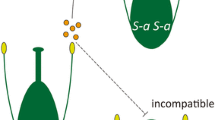Abstract
Soaking seeds in 5-azacytidine induced epigenetic and epiplastome variation in sugar beet. It hastens the early flowering of sugar beet, decreased the amount of not-flowering plants (flowerlcss, stemlcss), increased the number of second order branches in plants (epigenetic variability). 5-azacytidine influenced on the number of sub-cellular organelles in cytoplasm. It was also shown that 5-azacytidine reduces the chloroplasts number in stomata guard cells by 15–20% (epiplastome variability). It is possible that correlation exist between epiplastome and epigenetic variability in plants treated by 5-azacytidine.
Similar content being viewed by others
References
Bennet, M.D. (1972). Nuclear DNA content and minimum generation time in herbaceous plants.Proc. Royal Soc. London, Ser B,181: 109–135
Bennet, M.D. (1986). Nucleotypical basis for space order of eukaryotic chromosomes and its meaning for genome evolution and phenotypic variability. In: Genome evolution. Moscow, Myr, p. 234–256 (Russ.).
Fields, M.A. and Amyot, L.M. (1999). Evaluating the potential of using 5-azacytidine as an epimutagen.Can. J. Bot.,77: 1617–1622
Janousek, B., Siroky, Ju. and Vyskot, B. (1996). Epigenetic control of sexual phenotypes in dioecious plant,Melandrium album. Mol. Gen. Genet.,250: 483–490.
Maletskaya, S.S. and Kolodyazhnaya, J.S. (2000). Influence of the mode of plant reproduction on the polysomaty level of cell population on the example of sugar beet. In: Bio-diversity and Dynamics of Ecosystem in North Eurasia. Novosibirsk, Institute of Cytology and Genetics Siberian Department Russian Academy of Science, Part 1, p 60–62, 258 p.
Maletskii, S.I. (2001). Modelling of variability on chloroplasts number in stomata guard cells of sugar beet (Beta vulgaris L).Sugar Tech.,3(1&2): 13–17.
Panin, V.A., Panina, E.B., Zosimovich, V.P. and Lutkov, A.N. (1962). Method of mass obtaining and selection of tetraploid forms of sugar beet. Kiev, Ukraine Academy of Science press, 41 p. (Russ.).
Savitsky, H.I. (1966). Effectiveness of selection for tetraploid plants in Co generation on the basis of the number of chloroplasts in stomata.American Society of Sugar Beet Technologists,13(8): 655–661.
Strook, T.I. and Osipova, Z.A. (1982). Hybridization and polyploidy influence on leaf structure organisation in sugar beet. In: Population and genetic aspects of plants productivity (ed. S.I. Maletskii), Novosibirsk, Nauka, p. 77–86 (Russ.).
Judanova, S.S., Maletskaya, E.I. and Maletskii, S.I. (2002). Variability of chloroplasts number in population of stomata guard cells in sugar beet (Beta vulgaris L.).Russian Jour. Genetics,38(1): 58–63.
Author information
Authors and Affiliations
Rights and permissions
About this article
Cite this article
Maletskaya, E.I., Yudanova, S.S. & Maletskii, S.I. Epigenetic and epiplastome variability in apozygotic progenies of sugar beet with 5-azacytidine. Sugar Tech 4, 52–56 (2002). https://doi.org/10.1007/BF02956880
Published:
Issue Date:
DOI: https://doi.org/10.1007/BF02956880




